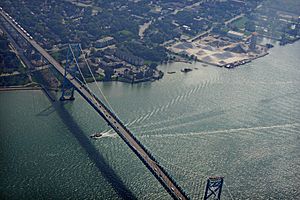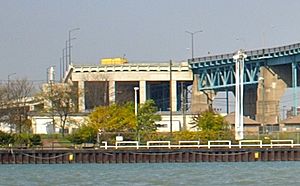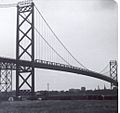Ambassador Bridge facts for kids
Quick facts for kids Ambassador Bridge |
|
|---|---|
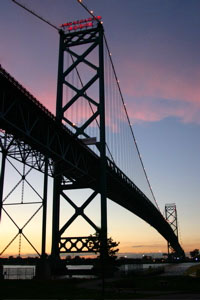
Ambassador Bridge from the Canadian side of the Detroit River
|
|
| Coordinates | 42°18′43″N 83°04′26″W / 42.312°N 83.074°W |
| Carries | 4 undivided lanes of |
| Crosses | Detroit River, Canada–United States border |
| Locale | Detroit–Windsor |
| Official name | Ambassador International Bridge |
| Maintained by | Detroit International Bridge Company and Canadian Transit Company |
| Characteristics | |
| Design | Suspension bridge |
| Total length | 7,500 feet (2,300 m) |
| Longest span | 1,850 feet (560 m) |
| Clearance below | 152 feet (46 m) |
| History | |
| Constructed by | McClintic-Marshall Company |
| Construction begin | August 16, 1927 |
| Construction end | November 6, 1929 |
| Opened | November 15, 1929 |
| Statistics | |
| Daily traffic | 10,000+ trucks per day, 4,000+ autos per day |
| Toll | US$5.00 / CA$6.25 |
| Lua error in Module:Location_map at line 420: attempt to index field 'wikibase' (a nil value). | |
The Ambassador Bridge is a large suspension bridge that crosses the Detroit River. It connects the city of Detroit, Michigan in the United States with Windsor, Ontario in Canada. This bridge is very important because it is the busiest international border crossing in North America for trade.
More than 25% of all goods traded between the United States and Canada cross this bridge. This huge amount of trade supports many jobs and businesses in the Detroit–Windsor area. The bridge is also special because it is one of the few privately owned crossings between the U.S. and Canada. It was owned by a family through the Detroit International Bridge Company and the Canadian Transit Company.
Contents
History of the Ambassador Bridge
The Ambassador Bridge first opened on November 15, 1929. The total cost to build this impressive bridge was about $23.5 million.
How the Ambassador Bridge Was Designed
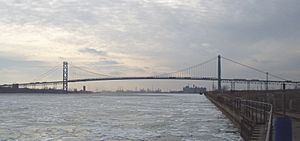
When it was finished in 1929, the Ambassador Bridge had the longest central span of any suspension bridge in the world. This main section over the river stretched for 1,850 feet (564 meters). This record was held until 1931.
Building the bridge started in 1927 and took two years to complete. The company that built it was McClintic-Marshall Company. The bridge used 21,000 tons (19,000 tonnes) of steel. The road on the bridge rises 152 feet (46 meters) above the Detroit River.
Only the main part of the bridge over the river hangs from large suspension cables. The parts leading up to the main towers are supported by strong steel structures. The bridge used to have a sidewalk on one side. However, for security reasons and ongoing maintenance, people are no longer allowed to walk or bike across the bridge.
The bridge was originally painted black. Between 1995 and 2000, it was repainted a different color, a shade of teal. Some of the old granite blocks from the U.S. side of the bridge were given to Windsor. Now, these blocks are used in pathways in parks there.
How Busy is the Ambassador Bridge?
The Ambassador Bridge is the busiest crossing along the Canada–United States border. On a normal weekday, more than 10,000 commercial trucks use its four lanes. A big project called the Gateway Project was finished in 2009. This project made it easier for traffic to get directly onto major highways like I-96 and I-75 in the U.S. and Highway 3 in Canada.
On the Canadian side, the bridge connects to busy city streets in Windsor. This can sometimes cause traffic jams. Overall, this privately owned bridge handles about 25% of all trade between Canada and the United States.
New Bridge Ideas for the Detroit River
Both the Canadian and United States governments have approved building a new bridge. This new bridge is called the Gordie Howe International Bridge. It will be built further down the Detroit River, connecting Detroit and Windsor. The Canadian government will own and operate this new bridge.
The previous private owner of the Ambassador Bridge did not want the new bridge to be built. He suggested building a second span next to the Ambassador Bridge instead, which he would own. However, officials supported the Gordie Howe International Bridge. This is because it will connect directly to major highways in both Canada and the U.S. This will help traffic avoid busy city streets in Windsor and reduce congestion.
In 2012, an agreement was made for the new bridge to go ahead. The Canadian government is funding its construction and related work in Michigan. The money will be paid back using tolls from the new bridge. The company that owns the Ambassador Bridge also proposed building its own new six-lane bridge next to the existing one. This new span would be a cable-stayed bridge. It would handle most of the traffic, with the original bridge used for extra vehicles.
However, building a second span right next to the Ambassador Bridge would not solve the problem of traffic on Windsor's city streets. The new Gordie Howe bridge is designed to connect directly to major highways, making travel smoother. In 2013, the U.S. government approved the permit for the new international crossing.
Images for kids
See also
 In Spanish: Puente Ambassador para niños
In Spanish: Puente Ambassador para niños


